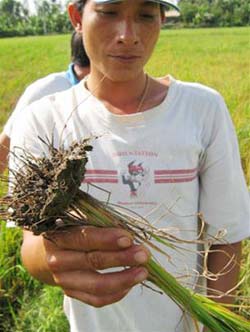Tens of thousands of farmers are losing sleep over the brown planthopper. Why is this pest proliferating, and how should we combat it? Below is an article by Professor Vo Tong Xuan.
Learning from Old Lessons
 |
|
Rice infected with yellow dwarf disease and leaf curl from Mr. Nguyen Van Huy (Tan Binh Commune, Cai Lay District, Tien Giang Province) shows root rot and empty grains… (Photo: T.T.D) |
While efforts to combat the brown planthopper are ongoing everywhere, in the Phu Tan nếp fields of the Tan My Hung Cooperative (An Giang), not a single brown planthopper can be found. This summer-autumn crop is expected to yield at least 4.5 tons per hectare. The farmers here are at ease, not having to worry about spraying pesticides like in other areas because they are using the IR 50404 rice variety, which is highly resistant to the pest…
Reflecting on the years 1976-1977, history seems to be repeating itself with the brown planthopper as the main culprit. At that time, we “closed” Can Tho University for nearly 2,000 students to go out and eliminate brown planthoppers.
Almost 200 points were established to propagate the IR36 rice variety resistant to brown planthoppers by the students. From these points, farmers exchanged rice seeds, and just two rice crops later, the brown planthopper was completely eradicated.
After IR36, many other high-yielding, pest-resistant rice varieties were developed by scientists from Can Tho University and the O Mon Rice Institute, notably IR64 and MTL50 (selected from the IR50404 base by the International Rice Research Institute), which stabilized the brown planthopper situation for a long time.
By 2005, the fields in the Mekong Delta were again infested with brown planthoppers, and sporadic patches of rice were infected with yellow dwarf disease and leaf curl transmitted by the brown planthopper.
Due to government downsizing, the agricultural extension network has significantly decreased, with fewer personnel visiting fields to detect pests early, especially brown planthoppers and leaf blight.
Meanwhile, traders, responding to the demands of rice export companies, encouraged farmers to grow as much “high-quality” rice as possible, such as Jasmine 85 and VD20, which are not resistant to brown planthoppers.
Moreover, many communes and districts encouraged farmers to plant a third rice crop. This creates an ideal condition for brown planthopper proliferation, as fields always have high-quality rice, which is not resistant to the pest, planted densely and fertilized heavily, while natural enemies have been wiped out due to improper pesticide application by farmers.
Let the Soil Rest!
Firstly, each farmer must learn to help themselves and not rely solely on agricultural extension or plant protection services. Farmers need to understand why their fields have brown planthoppers, when pesticide application is effective, when it should be avoided, which pesticides are effective against the pest, when to decisively uproot or bury diseased rice plants, and how to plant sparsely and apply balanced N-P-K fertilizers to prevent pests and diseases in the next crop.
Looking back, most of the recent disasters in the fields stemmed from farmers’ negligence and not adhering to scientific recommendations.
In Thailand, most farmers only grow one rice crop each year, particularly the Jasmine variety (Dawk Mali); only about 20% of the rice area is replanted with a second crop using high-yield short-duration varieties.
In contrast, our farmers do not allow the land to rest and cultivate three rice crops each year; while the third crop may yield some profit today, it has detrimental long-term effects due to soil depletion, environmental pollution from fertilizers and pesticides, and facilitating pest spread from one season to the next.
To prevent a recurrence of the brown planthopper infestation, the government needs to re-establish the agricultural extension and plant protection network; adjust regulations on the use of certified pest-resistant rice varieties, and firmly prevent farmers/locals from planting inferior fragrant rice. Farmers should be advised against planting a third crop during the rainy season and instead produce more economically viable crops and livestock, or ideally let the land rest for a season to absorb floodwaters and replenish nutrients.
Beware of the Black-Tailed Green Planthopper
|
It is time for farmers in the Mekong Delta to awaken: grow pest-resistant rice varieties only for two crops a year using the “three reductions – three increases” method to avoid yellow dwarf disease and leaf curl or planthopper blight. Do not chase after the trend of planting inferior fragrant rice. |
Another significant challenge may arise if farmers neglect pest-resistant rice varieties. The black-tailed green planthopper is now appearing alongside the brown planthopper, albeit in very low numbers.
This type of planthopper causes tungro disease, which is harder to treat than yellow dwarf disease and leaf curl. Tungro disease turns entire fields yellow, and rice plants lack enough chlorophyll to produce grains. The more farmers plant non-resistant rice varieties continuously for three crops a year, the more conducive it becomes for the planthopper to proliferate.
When tungro disease invades our country (as seen in the Philippines), we will have to import rice to meet our needs. The government must demonstrate its management role, and farmers need to adhere to agricultural techniques to effectively halt the brown planthopper and the black-tailed green planthopper disaster.
Professor Vo Tong Xuan


















































